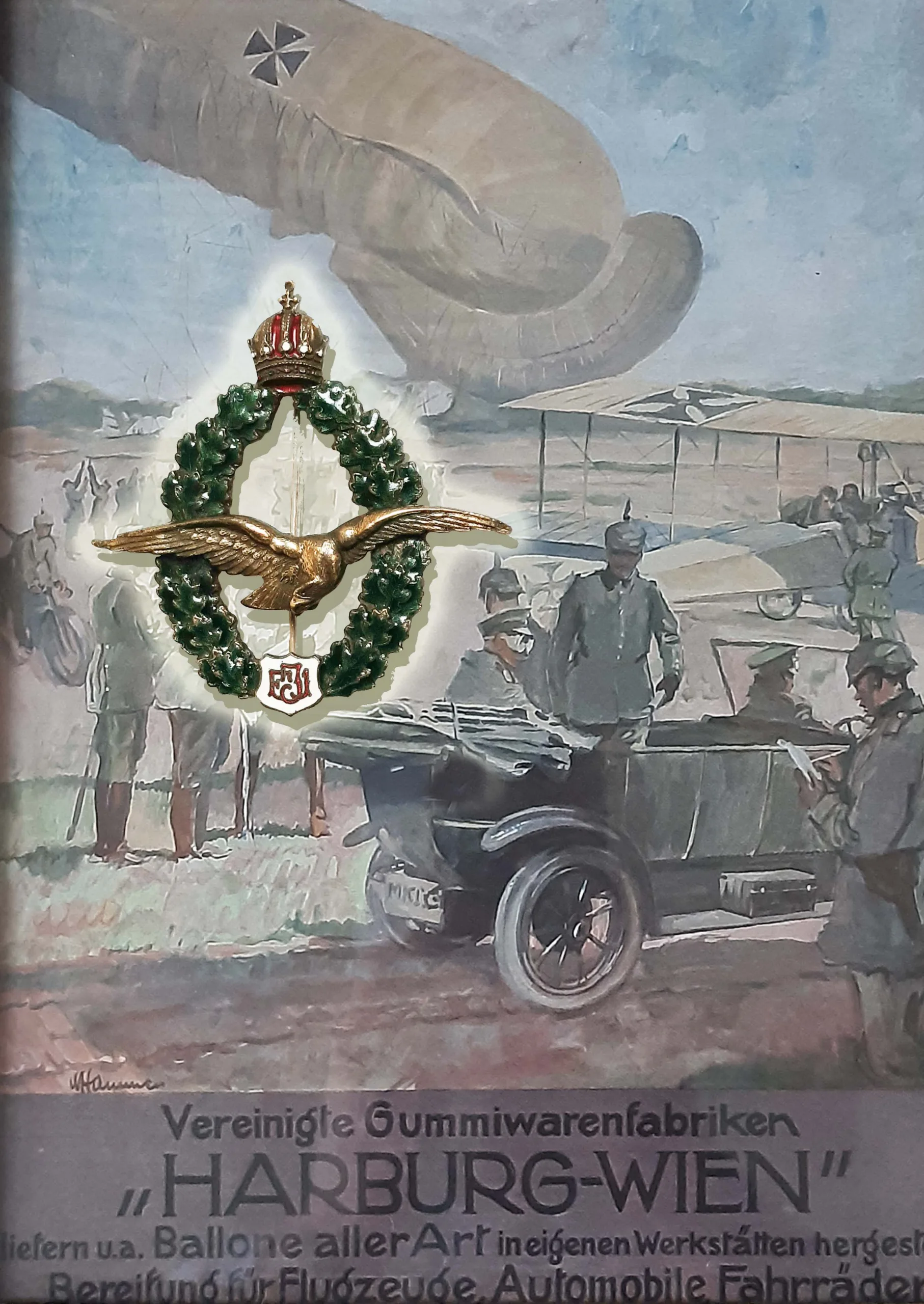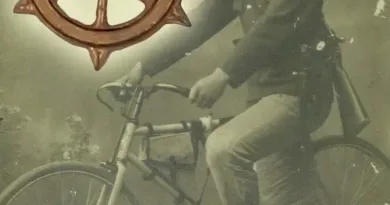Pilots’ qualification badge mark 1913
A post written by Gábor Széplaki
Rapid and comprehensive technical advances in the late 1800s also accelerated efforts to conquer the air. Although balloons were already of great importance in artillery reconnaissance in the great armies of the age, the Austro-Hungarian Monarchy lagged behind other leading great powers in the introduction of new aircraft techniques and technologies. Literally down to earth, commanders thought of balloons as a simple trade fair stunt, an amusement park toy, and considered the flight of heavier-than-air devices and their military use not worth mentioning. From 1906 onwards, attempts to fly in civilian environments multiplied and accelerated. The pioneers of the age built and tested many structures in the Monarchy, thus gaining tremendous knowledge and experience. On the Austrian side, Wiener-Neustadt played a leading role in this, where Austro-Daimler also employed Ferdinand Porsche at the time, who designed engines for many early aircraft. On the Hungarian side, Rákosmező near to Budapest was the main base for aviators.
The turning point was the appointment of Chief of Staff Franz Conrad von Hözendorf, who recognized the importance of the military use of aircraft. Through his actions, he helped to make the army an active user of this modern tool of the age. The Chief of Staff supported and also worked closely with representatives of civil aviation, while facilitating and accelerating the development of military aviation.
The Wiener Aero-Club was founded in 1901 and changed its name to the Österreichischer Aero-Club in 1908. From 1910, he conducted organized pilot training in accordance with the regulations of the Paris-based Fédération Aéronautique Internationale (FAI) and issued pilot certificates after passing the examination. The examination: a minimum of three individual circular flights of five kilometers and a stop within one hundred and fifty meters of the specified landing point after landing. Initially, the army did not have the necessary background, the training of the first military pilots took place under the auspices of the Austrian Aero Club.
On September 15, 1910, Conrad von Hözendorf visited the Austro-Daimler plant in Wiener Neustadt and its airport, where he took part in a short flight as a passenger. As a result of the positive personal experience, he made a proposal to the Department of Defense to support the training of four hundred pilots and the acquisition of two hundred aircraft for the military. This was still rejected at the time, but it sowed the seeds of the new kind of weapon to be born as the ministry began working out stricter conditions for field pilot training. The technical parameters of aircraft used in the army were also recorded.
In 1912, with the outbreak of the Balkan crisis, the time had come for military aviation to receive the attention and support it deserved. The most important measure was to speed up camp pilot training. This initially took place at the airports of Wiener Neustadt and Görz, but in parallel the infrastructure of Fischamend Airport, east of the capital, was also developed. In addition to practical training, the pilot students also received training in driving, vehicle assembly, flight theory, aerial surveillance, and other military subjects.
Between 1909 and 12, there was a continuous reorganization, in which balloon air observers were placed in the ranks of fort artillery and aircraft in a transport brigade called K.u.K Luftschifferabteilung (airship detachment). The unit was commanded by Lt. Col. Emil Uzalec, a Croatian engineer. At that time, the unit had 16 pilots, 12 aircraft of various makes, and some skilled technicians. After his appointment, the lieutenant passed the civil pilot examination and later successfully completed the field pilot training. From 1913, military pilot training and the development of the army accelerated. The training has already taken place at four established and continuously developed airports, in addition to Görz and Wiener-Neustadt, Fischamend and Novi Sad were also involved in the implementation of the project. By the end of 1913, an air base was established in Przemysl and Sarajevo.
Immediately before entering the war, the monarchy had 97 officer pilots, while Germany faced the first world burning with nearly 500 trained military pilots and observers. Uzalec urged that non-commissioned officers and crew soldiers also receive field pilot and observer training, but this was only allowed when the burning shortage of skilled flight crew came to light in the first year of the war.

By his supreme decision of September 11, 1912, the monarch regularized the wearing of a badge of honor for the field pilots. This is published in the Common Army Bulletin 2/1913. appeared in No. 1318, Section 2218 of the Circular of January 4, 1913. The shape and design of the badge was quite unusual compared to the skill awards discussed earlier, thus indicating that a much more difficult and very special skill was acquired by a proud wearer. It also differs from the badges of skill presented in previous articles in that, regardless of category, position, and rank, all field pilots received badges of the same design.

The material of the badge was gilded and enameled tombak. It was surrounded by an oval-shaped dark green enameled laurel wreath that framed an eagle with extended wings, also made of tombak. The eagle was riveted to the wreath at its wings. The lower part of the laurel branches was held together by a white enameled shield, on which the initials of the ruler’s name (FJI – Franz Josef I) can be read in red enamel. The top of the badge was closed by the enameled shape of the imperial crown. The badge was attached to the center of the right chest pocket of the uniform with a vertical needle on the back. Because the needle was broken in many cases, the damaged needle was replaced several times with hooks facing each other.

The manufacturer of the badge was the Zimbler company in Vienna, which also produced cases with spring locks for the badge. These bright red fabrics were coated with gold embossed imperial coat of arms. Case size: 97x84x27 mm. The inside was lined with white silk with the manufacturer’s gold-printed logo. Inside the lower part of the case, there was a vertical notch for the badge fastening needle, into which the badge could be perfectly fastened in the case.

The camp pilot badge was awarded by the Department of Defense to pilots who attended the training and passed the exam. From 1915, in addition, successful deployments of more than 10 flights over enemies had to be justified in order to be earned. The appointment of the field pilots and the awarding of the badge appeared in the personal affairs section of the bulletin. No standard document was issued for obtaining the title and badge, only an accompanying card could be issued per air force unit.

From 1916, the field pilot badge was temporarily awarded only for one year in retrospect. If the pilot was able to prove a total of more than 10 sorties over enemies for the previous 365 days, he earned the right to wear the badge for another year. If he could not prove this by the deadline, he had to return his badge to the Treasury through the official service channels.
The badge could be awarded permanently in the following cases:
– Pilot completed his training as a field pilot before December 31, 1913
– The beneficiary had continuously fulfilled the requirements for the award for four years
– The pilot was wounded during a deployment and was honored for his courage in front of the enemy

Another version of the badge is known, which differs from the copy published in the gazette in smaller details, mostly in the depiction of the imperial crown. According to some sources, this variant was made for themselves by field pilots in Wiener-Neustadt. So far, I have not been able to find an official source for this. There are also miniature versions of both badges. These were probably worn on the cap or officer’s pick.





[…] has already been talk in previous posts about the air force troops of the Austro-Hungarian Monarchy, this post is about the distinctive badge organized for […]